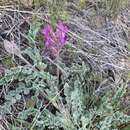Comprehensive Description
provided by North American Flora
Xylophacos inflexus (Dougl.) Rydb. Bull. Torrey Club
40:49. 1913.
A
Astragalus inflexus Dougl.; Hook. Fl. Bor. Am. 1: 151. 1831.
Tragacantha inflexa Kuntze, Rev. Gen. 945. 1891.
Phaca inflexa Piper, Contr. U. S. Nat. Herb. 11: 369. 1906.
A cespitose perennial; stems 1-5 dm., usually 2-3 dm. long, white-villous; leaves 7-12 cm. long, ascending; lower stipules deltoid-lanceolate, attenuate, the upper subulate, 5-8 mm. long; leaflets 15-27, lance-elliptic, acute at each end, 8-15 mm. long, 4-6 mm. wide, white-villous; peduncles 5-10 cm. long, villous; racemes 6-1 2 -flowered, 3-5 cm. long; bracts linear-subulate, attenuate, 8-15 mm. long; calyx white-villous, the tube about 1 cm. long, 4-5 mm. wide, the teeth subulate, 5-7 mm. long; corolla rose-purple, 20-22 mm. long; banner obovate, retuse, slightly arcuate; wings 3-4 mm. shorter, the blade oblong, with a large basal auricle; keelpetals still shorter, the blade broadly lunate, almost semicircular, obtuse, much shorter than the claw; pod 2-3 cm. long, 7-8 mm. thick, and 5-7 mm. wide, strongly arcuate throughout, densely villous, the upper suture sulcate except towards the tip.
Type locality: "Barren sandy grounds of the Columbia from the junction of the Lewis and Clark's River to the mountains" [probably Washington].
Distribution: Washington, Oregon. Idaho, and western Montana.
- bibliographic citation
- Per Axel Rydberg. 1919. (ROSALES); FABACEAE; PSORALEAE. North American flora. vol 24(1). New York Botanical Garden, New York, NY
Physical Description
provided by USDA PLANTS text
Perennial, Herbs, Stems woody below, or from woody crown or caudex, Taproot present, Nodules present, Stems prostrate, trailing, or mat forming, Stems less than 1 m tall, Stems solid, Stems or young twigs sparsely to densely hairy, Leaves alternate, Leaves petiolate, Stipules conspicuous, Stipules membranous or chartac eous, Stipules persistent, Stipules free, Leaves compound, Leaves odd pinnate, Leaf or leaflet margins entire, Leaflets opposite, Leaflets 10-many, Leaves hairy on one or both surfaces, Inflorescences racemes, Inflorescence umbel-like or subumbellate, Inflorescence axillary, Bracts very small, absent or caducous, Flowers zygomorphic, Calyx 5-lobed, Calyx glabrous, Petals separate, Corolla papilionaceous, Petals clawed, Petals blue, lavander to purple, or violet, Banner petal narrow or oblanceolate, Wing petals narrow, oblanceolate to oblong, Wing tips obtuse or rounded, Keel petals auriculate, spurred, or gibbous, Keel tips obtuse or rounded, not beaked, Stamens 9-10, Stamens diadelphous, 9 united, 1 free, Filaments glabrous, Style terete, Style persistent in fruit, Fruit a legume, Fruit unilocular, Fruit tardily or weakly dehiscent, Fruit oblong or ellipsoidal, Fruit coriaceous or becoming woody, Fruit exserted from calyx, Fruit beaked, Fruit hairy, Fruit 11-many seeded, Se eds cordiform, mit-shaped, notched at one end, Seed surface smooth, Seeds olive, brown, or black.

